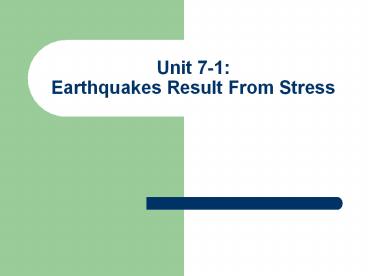Unit 7-1: Earthquakes Result From Stress - PowerPoint PPT Presentation
1 / 15
Title: Unit 7-1: Earthquakes Result From Stress
1
Unit 7-1Earthquakes Result From Stress
2
What is an Earthquake?
- Earthquake
- The shaking of the Earths crust caused by a
release of energy. - Earthquakes are caused by the motion of the
lithospheric plates. - Similar to volcano origins.
- Earthquakes are much more destructive, as they
affect a much larger area.
3
What is an Earthquake?
- Small earthquakes are very common.
- There are over a million earthquakes every year.
- This is roughly one earthquake ever 30 seconds.
- Many of these earthquakes are too small to be
noticed by anything but a sensitive piece of
scientific equipment called a seismometer.
4
What is an Earthquake?
- About 3000 result in moving a section of the
Earths crust. - Several hundred result in significant changes.
- About 20 result in severe changes.
5
What is an Earthquake?
- An earthquakes danger is directly related to how
close it is to human settlement. - The closer and more powerful the earthquake is to
a densely populated area, the more dangerous it
is. - The earthquake itself is only the start of the
destruction, as many more events are triggered by
earthquakes.
6
Causes of Earthquakes
- There are actually several causes of earthquakes
- Volcanic eruptions
- Cavern collapse
- Meteor impact
- The most common is due to stress that builds up
in the Earths crust. - Most scientists believe that stress occurs when
two lithospheric plates move past each other.
7
Causes of Earthquakes
- Fault Plane
- The surface that separates two lithospheric
plates. - The friction between the plates normally keeps
them in place. - However, every passing moment causes stress to
slowly build up.
8
Causes of Earthquakes
- As stress builds up, it eventually overcomes the
friction, then - WHAM!
- Earthquake!
- Elastic-Rebound Theory
- As stress and pressure are building up in the
plates, they deform. - When the earthquake occurs, the plates snap back
to their original shape.
9
Depth of Earthquakes
- The depth of the earthquake is dependent on the
type of plate boundary. - At a spreading or sliding boundary less than
30km - At a subduction boundary can be up to 700km
deep - Focus
- The actual location of the earthquake inside of
the earth.
10
Depth of Earthquakes
- Epicenter
- The location on the Earths surface directly
above the focus. - The deeper the earthquake is, the more
wide-spread the damage is. - A shallow earthquake is localized, while a deep
earthquake travels far.
11
Depth of Earthquakes
- Depth classification
- Shallow 60km or less
- Intermediate 60km-300km
- Deep 300km or deeper
- The discovery that earthquakes start deeper at
some plate boundaries was one of the first steps
in the development of the theory of plate
tectonics.
12
Earthquake Waves
- Earthquakes produce three types of wave motion.
- Each of these wave types travels at a different
speed and through different material. - The difference in speed is very important in
determining the epicenter.
13
Earthquake Waves
- Primary (P) Waves
- Back and forth wave motion.
- Alternately squeezes and stretches the rock it
passes through. - Can travel through any material
- Solid rock
- Magma
- Ocean Water
- Air
14
Earthquake Waves
- Secondary (S) Waves
- Vibrate at right angles to the P waves, so they
oscillate side to side as they move forward. - S-Waves can travel through solids, but not
through liquids. - The rate at which P and S waves move are
determined by the material they move through. - Regardless of the material, P waves move about
twice as fast as S waves.
15
Earthquake Waves
- Surface (L) Waves
- The final type of wave generated by an
earthquake. - These waves travel forward while rolling like an
ocean wave. - These are among the more destructive wave created
as this causes the most movement of the surface.































